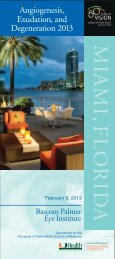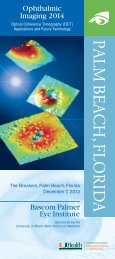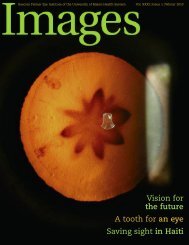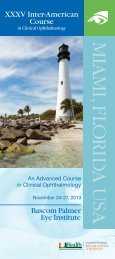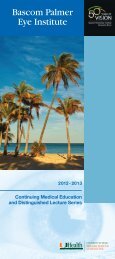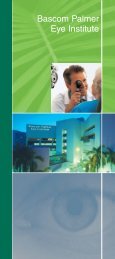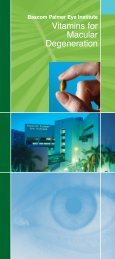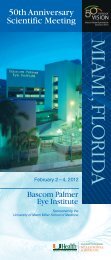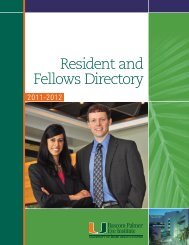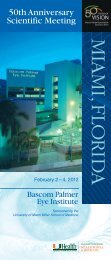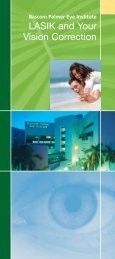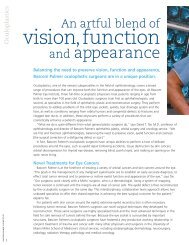Images Magazine Spring 2013 - Bascom Palmer Eye Institute
Images Magazine Spring 2013 - Bascom Palmer Eye Institute
Images Magazine Spring 2013 - Bascom Palmer Eye Institute
- No tags were found...
You also want an ePaper? Increase the reach of your titles
YUMPU automatically turns print PDFs into web optimized ePapers that Google loves.
featureinvolving <strong>Bascom</strong> <strong>Palmer</strong>’sclinicians, researchers,biomedical engineers andvoluntary faculty.This successful procedureopened the door to manynew types of treatments forretinal tears, detachments andscar tissue, as well as macularholes, vitreous hemorrhage,traumatic injuries and otherconditions. “For a youngresearcher, <strong>Bascom</strong> <strong>Palmer</strong>offered an ideal environment,where credit was given to any individual who made a discovery,” said Machemer in a 2007 interview.“It was in this supportive environment that the new art of vitreous surgery evolved.”Back in 1969, Machemer met Jean-Marie Parel, Ph.D., Ing., ETS-G, a Swiss-born biomedicalengineer who was developing motorized microsurgical instruments, in Melbourne, Australia. Theyconceived the idea for an instrument (later called the Vitreous Infusion Suction Cutter or VISC)that could be introduced through the pars plana in order to aspirate, cut and remove the diseasedvitreous while maintaining the shape of the eye through the continuous infusion of saline solution.“It was one tool that would do three different things, “said Parel, who joined the <strong>Institute</strong> in1970. “It provided the foundation for doing intraocular microsurgery while preventing the collapseof the eye.” Most importantly, the early prototype VISC made Machemer’s surgery a success. “Iused that little instrument and it worked,” Machemer said. “The patient, who could only see handmovements, saw 20/40 after the operation.”Two decades later, retinal specialist William E. Smiddy, M.D., contributed to the developmentof vitrectomy for the treatment of macular holes which occur in the central part of the retina. Todayvitrectomy enables surgeons to close about 90 percent of macular holes, a condition previouslythought untreatable.1972Gold Medal findingsDouglas R. Anderson, M.D.,and Ralph Kirsch, M.D.,collaborate to study theoptic nerves of patientswith or without glaucoma.The doctors win a goldmedal for a presentationof their findings at theAmerican Academy ofOphthalmology.1974Richard K. Forster, M.D.,pioneers the use of intraocularantibiotics for endophthalmitis.1976Donor recognitionAnne Bates Leach proudly displaysa rendering of the new hospitalnamed in her honor. Leach donates$4.5 million to the eye hospital thatbears her name.9



